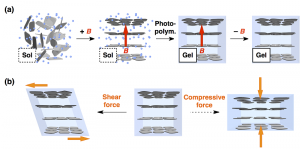Simple synthetic hydrogel is hard vertically and supple horizontally Potential as artificial cartilage and anti-vibration material

Professor Takuzo Aida at the University of Tokyo, team leader Yasuhiro Ishida at RIKEN, and Takayoshi Sasaki at the National Institute for Materials Science and their colleagues have developed a novel hydrogel with mechanical properties that are highly anisotropic (different depending on direction), and which contains negatively charged inorganic nanosheets that are oriented in layers facing the same direction by magneto-induced ordering.

© 2015 Takuzo Aida.(a) By in-situ gelating an aqueous dispersion of the nanosheets in a magnetic flux, cofacial ordering of the nanosheets can be fixed. (b) The resultant hydrogel easy deforms along a shear force applied parallel to the nanosheet plane but is highly resistive against a compressive force applied orthogonally.
Electrostatic and magnetic repulsive forces are used in a variety of applications, such as maglev trains. However, design of polymer materials, such as rubbers and plastics, has focused overwhelmingly on attractive interactions for their reinforcement, while little attention has been given to the utility of internal repulsive forces. Nevertheless, in nature, articular cartilage in animal joints is composed of a polymer incorporating a high density of negative charges creating an electrostatically repulsive force that results in extremely low mechanical friction between surfaces even under high compression.
The research group discovered that when nanosheets of unilamellar titanate dispersed in an aqueous medium are subjected to a strong magnetic field, they align in layers facing one another, and a large and anisotropic electrostatic repulsion emerges between the nanosheets. This structural ordering can be fixed by transforming the dispersion into a hydrogel. The anisotropic electrostatics thus embedded allows the hydrogel to show unprecedented mechanical properties, where the hydrogel easy deforms along a shear force applied parallel to the nanosheet plane but is highly resistive against a compressive force applied orthogonally.
The concept of embedding repulsive electrostatics in a composite material, inspired from articular cartilage, will open new possibilities for developing soft materials with unusual functions.
Press release (RIKEN)
Paper
Mingjie Liu, Yasuhiro Ishida, Yasuo Ebina, Takayoshi Sasaki, Takaaki Hikima, Masaki Takata and Takuzo Aida,
“An anisotropic hydrogel with electrostatic repulsion between cofacially aligned nanosheets”,
Nature 517 2015: 5 (68-72), doi: 10.1038/nature14060.
Article link (Publication, UTokyo Repository)
Links
Graduate School of Engineering
Department of Chemistry and Biotechnology, Graduate Graduate School of Engineering
RIKEN Center for Emergent Matter Science
National Institute for Materials Science, International Center for Materials Nanoarchitectonics







